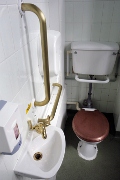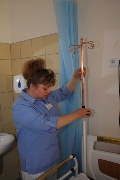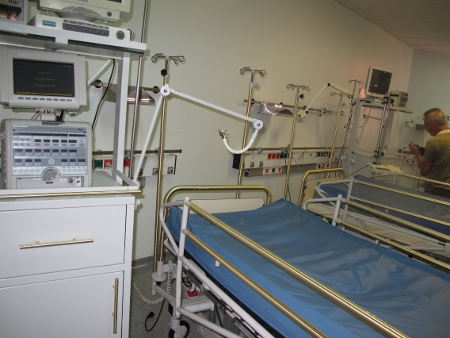Last month, York Health Economics Consortium (YHEC) revealed a business case model showing that the installation of antimicrobial copper touch surfaces in hospital intensive care units pays for itself in less than 12 months due to the resulting reduction in bacteria and the potential saving from reduced healthcare associated infections1. It draws on clinical trial results from Selly Oak Hospital in the West Midlands and others overseas, which have continued to increase the evidence base for the efficacy of copper and copper alloys in fighting superbugs such as MRSA. This week BBH editor, Jo Makosinski, spoke to BRYONY SAMUEL of Copper Development Association about the impact of this research and what it means for the future of infection control in healthcare settings
The bug-busting effect of copper was not a 21st-Century discovery.
Bronze is arguably mankind’s oldest metal, giving its name to a period following its development nearly 6,000 years ago. Bronze today is a widely-used copper alloy that benefits from its antimicrobial efficacy, and ancient Greek soldiers are reported to have scraped the bronze from their swords into open wounds to reduce the likelihood of infection.
It was well-established that antimicrobial copper surfaces drastically lower contamination – continuously and in between regular cleans – but no one had previously explored the effect that has on patients.
Copper was also a mainstay in the medical chests of the ancient Egyptians, who performed complex medical operations using copper alloy instruments and alleviated infections with copper-containing salves. In addition, copper vessels are still used in India to store water as it is widely recognised to limit the growth of harmful pathogens.
Of course, in modern times the burden of proof is much greater than that accepted by ancient cultures. But, a few thousand years after those early discoveries, scientists are once again recognising the impact copper and its alloys - collectively termed ‘antimicrobial copper’ - have on reducing the presence of bacteria, particularly on touch surfaces.
“There is now a solid evidence base from laboratory experiments and clinical trials around the world,” says Samuel. “This is a big step change for the health service, which has been looking for the most effective ways of reducing bioburden in medical environments.”
The UK has taken a lead in evidence gathering, mainly through the work of Professor Bill Keevil, chairman of environmental healthcare at the University of Southampton. Picking up where the ancient civilisations left off, he was behind the first laboratory tests demonstrating the ability of copper and copper alloys to rapidly and completely kill bacteria, viruses and fungi. To see if these findings could be applied to the healthcare environment, a major clinical trial was undertaken at Selly Oak Hospital in Birmingham, assessing the reduction in contamination achievable by installing antimicrobial copper surfaces.
The US trial shows that this intervention has a direct impact on patient outcomes, and as such can save lives and money
The research, carried out on a busy medical ward in 2007, found a 90-100% reduction in bioburden on antimicrobial copper surfaces. This was the first time its bug-busting properties had been observed outside of the laboratory. Subsequent trials in the US and Chile recorded similar results, despite their very different climates. These provide vital evidence of the efficacy of copper at normal room temperatures, negating the need for specific climate control and the associated costs.
However, the biggest development in terms of collecting the evidence to support its widespread use came from a three-centre Department of Defense-funded trial in the US, which went a step further by looking at the knock-on effect of controlling bioburden in a clinical environment. Preliminary results showed that patients treated in a room in which just six key touch surfaces had been upgraded with antimicrobial copper equivalents had a greater than 40% lower risk of acquiring a healthcare associated infection (HCAI) than those treated in non-copper rooms.

One of the world\'s biggest trials took place at Selly Oak Hospital in Birmingham
Samuel says: “It was well-established that antimicrobial copper surfaces drastically lower contamination – continuously and in between regular cleans – but no one had previously explored the effect that has on patients. The US trial shows that this intervention has a direct impact on patient outcomes, and as such can save lives and money. The business case recently developed by YHEC sheds more light on these results.”
Research has shown that the hospital touch surfaces most likely to harbour high levels of pathogens are, unsurprisingly, those nearest to the patient and used most frequently by them, visitors and healthcare workers. The US trial found six major sources: bed rails, overbed tables, chair arms, nurse call buttons, IV poles, and data input devices such as keyboards.
Where these products are concerned, replacing the touch surfaces with antimicrobial copper has been found to destroy pathogens and break the chain of infection.
We want healthcare organisations to understand exactly what copper can do to help with infection prevention and control, offering a cost-effective additional measure alongside hand hygiene and regular surface cleaning to create a safer environment for patients, their visitors and healthcare workers
The reason why copper has this effect is still under investigation by teams around the world, including Professor Keevil. What is known is that copper causes a cascade of negative events in microbial cells, causing them to die very rapidly. In laboratory tests, copper bound to proteins that do not require it caused leakage of potassium or glutamate through the outer membrane of bacteria, disturbed osmotic balance, and created oxidative stress by catalysing local redox reactions generating hydrogen peroxide.
The Copper Development Association has taken all this evidence and is now turning it into simple guidance for healthcare organisations. It also provides an independent overview of the science and details of the growing range of products currently available on the market.

Copper is replacing stainless steel for a lot of key touch surfaces, including IV stands
Samuel says: “The evidence is growing very rapidly, so it can be difficult for people to keep up with the latest developments. We want healthcare organisations to understand exactly what copper can do to help with infection prevention and control, offering a cost-effective additional measure alongside hand hygiene and regular surface cleaning to create a safer environment for patients, their visitors and healthcare workers.”
In terms of choosing products, those made from pure copper exert the most rapid effect. Many alloys containing more than 60% copper are also known to offer significant antimicrobial efficacy. More than 450 alloys are now registered with the US Environmental Protection Agency as being permitted to make public health claims, which is a first for solid surfaces.
Alloys are attractive to architects and designers as they offer a wide variety of colours – from the gold brasses and warm brown bronzes to a silver that looks like stainless steel – thus providing options to suit any design aesthetic.
Samuel says: “The advantage of alloys is in the choices they offer, both in terms of colour and properties. Brass and bronze are very hard-wearing and also extremely familiar to us – we see them all around us in daily life, from statues to door furniture to coinage, even as stair rails and edges at London Underground stations.”
But does this mean hospitals will have to pay a premium up front to install copper surfaces? Samuel claims not.
She says: “The cost of the material is a very tiny part of the overall cost of a product. Many copper alloys are extremely versatile and easy to work with, so they do not present a challenge for manufacturers who are likely accustomed to using them already. As part of a planned renovation or a new-build, antimicrobial copper touch surfaces are a very appealing option in terms of what they offer a hospital. YHEC’s business case model shows just how quickly payback can be achieved through reduced patient bed days and treatment costs, and of course that’s without taking into account reduced suffering and mortality, which are without price.”
This value is evident in the marketplace, with a handful of forward-thinking firms offering to make products using copper for no additional price. These include Allgood and Pegler Yorkshire, where product market manager, Mike Dickinson, said: “As the healthcare industry strives to prevent the transfer of infectious bacteria, it is imperative that manufacturers develop new products to help combat the issues facing the sector.
The US trial shows that this intervention has a direct impact on patient outcomes, and as such can save lives and money
“The results of research conducted by specialists across the world has shown that the antimicrobial benefits of copper far outweigh any other product on the market. These are the most-effective touch surfaces and are ideal for the healthcare environment where their inherent, continuous ability to kill bacteria will supplement infection control measures.”
“The best time to consider this issue is during a refurbishment,” adds Samuel. “Hospitals will want to look at the particular environment they are planning, whether it’s a general ward or something more specialist such as an intensive care unit or – as with an antimicrobial copper installation at Sheffield’s Northern General Hospital – a Cystic Fibrosis (CF) unit. They need to decide what their needs are and I would encourage them to ask questions or come to us for advice and assistance.”
As hospitals in the UK continue to embrace copper as a new surface material, studies are ongoing in France, Spain, South Africa, Greece and Japan, and Professor Keevil is undertaking further work to determine exactly why copper has this effect on such a variety of microbes.

Trials of copper touch surfaces are taking place around the world, including at Attikon Hospital in Greece (pictured)
UK health centres that have already embraced the use of copper for infection control include Craigavon Hospital in Northern Ireland, where copper ironmongery has been installed in the trauma and orthopaedic areas and in the maternity unit and operating theatres. Traditional fittings have been replaced with copper products for the past three years as part of a drive by Milligan Reside Larkin Architects to show how the design of buildings can aid infection control.
Copper touch surfaces were also used during the refurbishment of the adult rehabilitation unit at Homerton University Hospital in London. The products are from Allgood’s Contego range and are an example of how a copper alloy can be used to give the appearance of stainless steel, while still retaining the infection prevention properties of copper.
Graham Shirville, Chairman of Allgood, said of the installation: “The range offered the client the antimicrobial protection of copper with the appearance of stainless steel, fitting in with the desired aesthetic while helping to protect patients from the pathogens that cause healthcare-associated infections.”
And speaking about the impact copper has had on the CF unit at the Northern General Hospital, one of its consultants, Dr Frank Edenborough, said: “In a bid to set the gold standard for infection prevention in CF, we felt that copper could make an important contribution towards minimising surface contamination from hands or coughing, killing potentially-dangerous pathogens in between cleans and augmenting rigorous hygiene protocols. It is our hope that, in this way, copper will help reduce the risk of infections."
Architect Rebecca Haverty of Race Cottam Associates, the practice behind the cutting-edge unit, added that it was becoming a more important consideration for designers.
“Common materials such as plastics may look clean, but they have no inherent antimicrobial efficacy," she said. "Antimicrobial copper can help to fight infection, so we were very keen to use it. It seems almost too good to be true and yet it's proven to work. The range of alloys available means any project can gain from the benefits of copper. We chose to use an almost pure copper to make a statement, but a nickel silver finish would look good too."

Door handles at the Northern General Hospital in Sheffield have been changed to copper in an effort to reduce infections such as MRSA
Copper facts
- Copper is man's oldest metal, dating back more than 10,000 years. A copper pendant discovered in what is now northern Iraq dates back to about 8700 BC
- The Romans obtained their copper from Cyprus. It was called aes Cyprium, which means ‘metal of Cyprus’. This was later shortened to cyprium and even later to coprum, eventually becoming known in English as copper
- Copper is a mineral and is used widely in industry because of its high ductility, malleability, thermal and electrical conductivity and resistance to corrosion
- The melting point of pure copper is 1,981°F (1,083°C, 1356°K)
- Currently, there are more than 450 recognised copper alloys; brasses and bronzes being the most well known. Brasses are mainly a mixture of copper and zinc, while bronzes are mainly copper along with alloying elements such as tin, aluminum, silicon or beryllium. Alloys are identified by numbers preceded by a ‘C’ and more than 350 have been acknowledged as having antimicrobial properties
- Uses for copper over the millennia have included making the chisels used to smooth the limestone blocks of the great pyramids, for medical equipment and instruments, as currency, to clad the underwater hulls of ships and to prevent seawater corrosion in marine piping systems, for cookware due to its high heat transfer properties, and for weapons and armour. It is also widely used in architecture, including the massive doors to the temple of Amen-Re at Karnak in Egypt, which were clad with copper; the solid copper ‘Golden Temple’ in Kunming, China; and the famous baptistery doors of Italy's Florence Cathedral
- Copper is an essential nutrient in our daily diet. It is needed for the normal growth and development of human foetuses, infants and children. In adults, it is necessary for the growth, development and maintenance of bone, connective tissue, brain, heart and many other body organs. Copper is also involved in the formation of red blood cells, the absorption and utilisation of iron, and the synthesis and release of life-sustaining proteins and enzymes
- Copper-rich foods include grains, nuts and seeds, organ meats such as liver and kidneys, shellfish, dried fruits, legume vegetables such as string beans and potatoes, chicken and some unexpected sources such as cocoa and chocolate
- AND FINALLY…… A copper strip barrier can keep snails and slugs from entering your garden. The slime they generate creates an electrical charge when contacting the copper and discourages the pests from crossing
